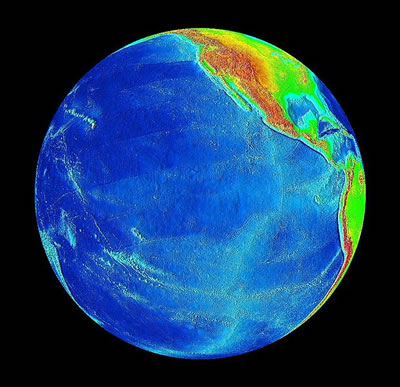The Pacific Ocean is the largest and the deepest ocean on Earth.
It was formed when the supercontinent Pangaea broke up.
More than half of the people on Earth live along the shores of the Pacific Ocean.
The oldest parts of the Pacific Ocean are about 135 million years old.
 The Pacific Ocean is decreasing in size as continental plates move together. At the same time, the Atlantic Ocean is becoming larger.
The Pacific Ocean is decreasing in size as continental plates move together. At the same time, the Atlantic Ocean is becoming larger.
At the eastern edge of the Pacific, a mountain range runs along the length of the Americas.
The eastern Pacific basin is generally flat and about 15,000 feet (4,570 meters) deep on average.
A series of deep ocean trenches surround the western Pacific basin, which has many island arcs.
The Mariana Trench, in the western Pacific Ocean, is the deepest oceanic trench in the world - 36,201 feet (11,034 meters) deep.
An active ridge runs through the Pacific Ocean from the northeast to the southeast.
The South Pacific has many coral reefs and coral atolls, made of calcium carbonate from the skeletons of millions of coral polyps.
Ring of Fire
Many different oceanic plates occupy the Pacific basin. These plates, which are thinner than continental plates, are constantly moving. When they collide with continental plates, they are forced underneath the continental plates creating subduction zones, with high ridges and deep trenches.
Subduction zones are characterized by high levels of volcanic activity, earthquakes and tsunamis.
The ring of continental plate margins that surrounds the Pacific Ocean is known as the Ring of Fire. Known for frequent seismic activity, the Ring of Fire has many underwater mountain ranges and volcanic islands. The largest mountains in the Ring of Fire appear as island arcs above the surface of the water.